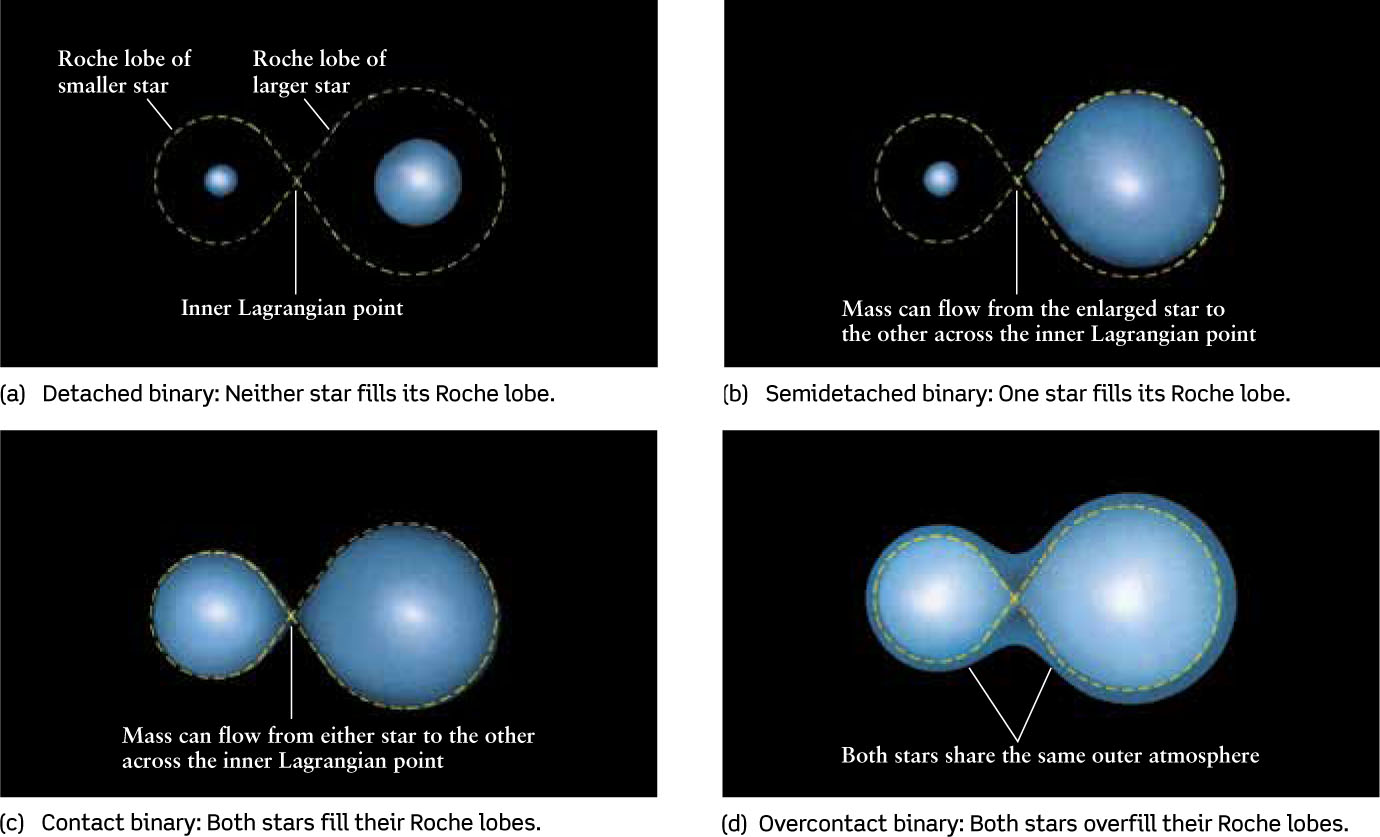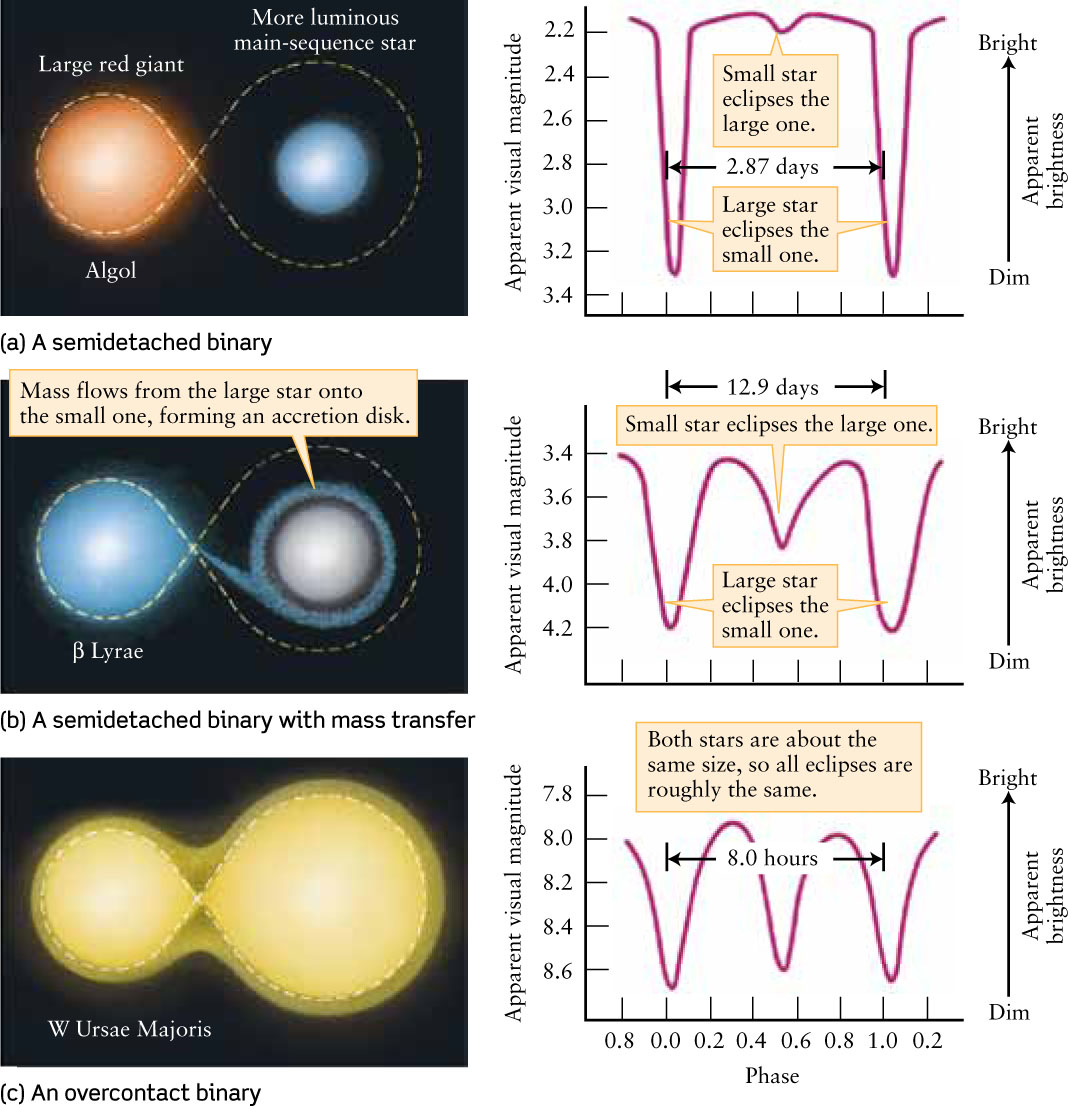19-7 Mass transfer can affect the evolution of stars in a close binary system
We have outlined what happens when a main-sequence star evolves into a red giant. What we have ignored is that more than half of all stars are members of multiple-star systems, including binaries. If the stars in such a system are widely separated, the individual stars follow the same course of evolution as if they were isolated. In a close binary, however, when one star expands to become a red giant, its outer layers can be gravitationally captured by the nearby companion star. In other words, a bloated red giant in a close binary system can dump gas onto its companion, a process called mass transfer.
Roche Lobes and Lagrangian Points
If the stars in a binary system are sufficiently close, tidal forces can pull gases off one star and onto the other
Our modern understanding of mass transfer in close binaries is based on the work of the French mathematician Edouard Roche. In the mid-1800s, Roche studied how rotation and mutual tidal interaction affect the stars in a binary system. Tidal forces cause the two stars in a close binary to keep the same sides facing each other, just as our Moon keeps its same side facing Earth (see Section 4-8). But because stars are gaseous, not solid, rotation and tidal forces can have significant effects on their shapes.
In widely separated binaries, the stars are so far apart that tidal effects are small, and, therefore, the stars are nearly perfect spheres. In close binaries, where the separation between the stars is not much greater than their sizes, tidal effects are strong, causing the stars to be somewhat egg-shaped.
Roche discovered a mathematical surface that marks the gravitational domain of each star in a close binary. (This surface is not a real physical one, like the surface of a balloon, but a mathematical construct.) Figure 19-21a shows the outline of this surface as a dashed line. The two halves of this surface, each of which encloses one of the stars, are known as Roche lobes. The more massive star is always located inside the larger Roche lobe. If gas from a star leaks over its Roche lobe, it is no longer bound by gravity to that star. This escaped gas is free either to fall onto the companion star or to escape from the binary system.

The point where the two Roche lobes touch, called the inner Lagrangian point, is a kind of balance point between the two stars in a binary. It is here that the effects of gravity and rotation cancel each other. When mass transfer occurs in a close binary, gases flow through the inner Lagrangian point from one star to the other.
In many binaries, the stars are so far apart that even during their red-giant stages the surfaces of the stars remain well inside their Roche lobes. As a result, little mass transfer can occur and each star lives out its life as if it were single and isolated. A binary system of this kind is called a detached binary (Figure 19-21a).
However, if the two stars are close enough, when one star expands to become a red giant, it may fill or overflow its Roche lobe. Such a system is called a semidetached binary (Figure 19-21b). If both stars fill their Roche lobes, the two stars actually touch and the system is called a contact binary (Figure 19-21c). It is quite unlikely, however, that both stars exactly fill their Roche lobes at the same time. (This would only be the case if the two stars had identical masses, so that they both evolved at exactly the same rate.) It is more likely that they overflow their Roche lobes, giving rise to a common envelope of gas. Such a system is called an overcontact binary (Figure 19-21d).
CONCEPT CHECK 19-15
What happens if the mass from one star enters the Roche lobe of another star?
If a star expands enough that some of its mass enters the Roche lobe of its binary companion, the matter becomes gravitationally bound to the binary companion. Over time, this can transfer a significant amount of mass to the companion.
Observations of Mass Transfer
The binary star system Algol (from an Arabic term for “demon”) provided the first clear evidence of mass transfer in close binaries. Also called β (beta) Persei, Algol can easily be seen with the naked eye. Ancient astronomers knew that Algol varies periodically in brightness by a factor of more than 2. In 1782, John Goodricke (the discoverer of δ Cephei’s variability) first suggested that these brightness variations take place because Algol is an eclipsing binary. (We discussed this type of binary in Section 17-11.) The orbital plane of the two stars that make up the binary system happens to be nearly edge-on to our line of sight, so one star periodically eclipses the other. Algol’s light curve (Figure 19-22a) and spectrum show that Goodricke’s brilliant hypothesis is correct, and that Algol is a semidetached binary. The detached star (on the right in Figure 19-22a) is a luminous blue main-sequence star, while its less massive companion is a dimmer red giant that fills its Roche lobe.

CAUTION!
According to stellar evolution theory, the more massive a star, the more rapidly it should evolve. Since the two stars in a binary system form simultaneously and thus are the same age, the more massive star should become a red giant before the less massive one. But in Algol and similar binaries, the more massive star (on the right in Figure 19-22a) is still on the main sequence, whereas the less massive star (on the left in Figure 19-22a) has evolved to become a red giant. How can we explain this apparent contradiction? The answer is that the red giant in Algol-type binaries was originally the more massive star. As it left the main sequence to become a red giant, this star expanded until it overflowed its Roche lobe and dumped gas onto its originally less massive companion. Because of the resulting mass transfer, that companion (which is still on the main sequence) became the more massive star.
Mass transfer is also important in another class of semidetached binaries, called β (beta) Lyrae variables, after their prototype in the constellation Lyra. As with Algol, the less massive star in β Lyrae (on the left in Figure 19-22b) fills its Roche lobe. Unlike Algol, however, the more massive detached star (on the right in Figure 19-22b) is the dimmer of the two stars. Apparently, this detached star is enveloped in a rotating accretion disk of gas captured from its bloated companion. This disk partially blocks the light coming from the detached star, making it appear dimmer.
What is the fate of an Algol or β Lyrae system? If the detached star is massive enough, it will evolve rapidly, expanding to also fill its Roche lobe. The result will be an overcontact binary in which the two stars share the gases of their outer layers. Such binaries are sometimes called W Ursae Majoris stars, after the prototype of this class (Figure 19-22c).
Mass transfer can also continue even after nuclear reactions cease in one of the stars in a close binary. In Chapters 20 and 21 we will see how mass transfer onto different types of dead stars called white dwarfs, neutron stars, and black holes can produce some of the most unusual and dramatic objects in the sky.